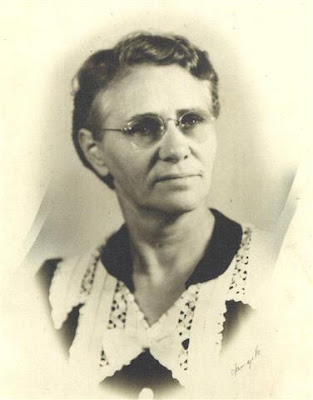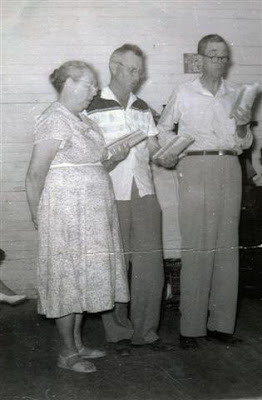Mike and Pat with their hives in Spring 2009
Beekeeping in Peaceful Valley is nothing new although it has been several years since bees have been kept in the Valley. The last beekeeper was William Hugh Pennington who died in 1959. Known as "Big Daddy" to his grandchildren and great-grandchildren, he had hives into the 1940s. During a recent conversation with his daughter, my Aunt Tootsie, she told me that when she was growing up her father kept two or three bee hives near the storm cellar to the right of their house.
Big Daddy told Tootsie that the bees had to be handled very gently and that you had to let them know that you were not afraid of them. Tootsie, who was afraid of bees but loved their honey, would stand in the distance and watch her father as he robbed his hives. She watched him as he would take his hammer and gently tap the nails from underneath to loosen the wooden top, then gently take off the top and reach into the hive to remove the honey and honeycomb into a dishpan waiting on a nearby table.
One of the things that Big Daddy did to prepare for his honey-robbing was to tightly roll up an old piece of cloth, usually an old quilt piece, and tie it with a string. He would then set the cloth on fire, let it burn out and start smoking. This smoking piece of clothe would be laid on the ground for use in case the bees became angry at which time Big Daddy would pick up the smoking cloth and wave it at the bees to calm them. Aunt Tootsie said that rarely did Big Daddy have to do this however.
If a bee did sting Big Daddy, he would reach over and gently lift the bee between his fingers and wave it off of him. Generally though, Big Daddy rarely got stung. He didn't have special apparel that he wore when working with his bees, but Tootsie noted that he would roll down his sleeves and button his shirt at his wrists. Uncle Joe Blake, Big Daddy's brother-in-law, kept bee hives in Peaceful Valley too. He had a straw hat with netting that Aunt Zadie Blake had created, and Uncle Joe wore this hat when he robbed his hives. Uncle Gainey and Uncle Luther were both nervous around bees and thus didn't have hives, but Tootsie said that she remembers Uncle Gainey would keep an eye out in the woods for trees with holes or knots in them that might harbor bees and then let Big Daddy know about them.
Unlike today, there were many wild bees that could be found in the woods. If a tree looked like a potential spot for a bee hive, it would be watched closely for bee activity. When the bees started swarming outside, this was a signal that it was time to rob the hive in the tree. Big Daddy would cut down the tree as gently as he could. Often, he would have Uncle Joe there to help, and they would not only get the honey, but also the bees as well. How did they capture the bees? Tootsie said they could get the bees to stop swarming by banging on a plow with anything metal. The bees would swarm to the plow where an empty hive had been placed nearby awaiting the bees.
Tootsie said that there was no sound like the sound of swarming bees. Everyone recognized the sound and knew what to do. You were to get something metal and beat on it with a metal spoon or rod to stop the bees until the swarm could get captured. Tootsie herself did this a couple of times although after doing so she would run to the fields to get help from Big Daddy. She told me that you could see the swarm of bees as a ball flying through the air.
After robbing the bee hives, the honey and comb would be collected and put into quart jars. If the honey was particularly bountiful, some would be shared with neighbors who would do likewise when they robbed their bee hives. The honeycomb was what Tootsie loved; she would cut off a chunk to suck out the honey and then chew on the remaining comb. A jar of honey was generally kept on the dinner table and made a meal of biscuit and gravy especially tasty. Some things never change!
Big Daddy's son, Fessie, wasn't a beekeeper but he allowed the Homans of Shannon to keep some hives on his farm back during the 70s and 80s. In exchange, the Homans kept Fessie and Beck in honey. The Homan brothers, who still are in the bee business, were a great resource for Mike when he re-established new colonies of bees in Peaceful Valley last year. According to the Homans, the honey from Peaceful Valley bees has a unique taste due to the peppervine plant that grows down in the Tombigbee River bottom. This is true. The small bit of honey that was gathered last year had a wonderfully distinctive flavor.
Last year was not a good year for the Peaceful Valley bees. The early summer months were unusually wet, and the bees did not have enough opportunities to gather pollen for their hives. They had honey heading into the fall, but not enough for us to rob their hives and still leave the bees some to live on during the winter months. Just a little bit was gathered, shared, and quickly gone. Winter was hard on the bees too, with two or three long hard freezes, but most of the bees came through with some minor losses.
With the coming of spring, new bees have been acquired and placed inside newly built hives. More hives should equate into more honey but we'll see how it goes. I'll keep you posted.





































